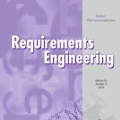In large-scale embedded system development, requirement and test specifications are often expressed in natural language. In the context of developing such products, requirement review is performed in many cases manually using these specifications as a basis for quality assurance. Low-quality specifications can have expensive consequences during the requirement engineering process. Especially, if feedback loops during requirement engineering are long, leading to artifacts that are not easily maintainable, are hard to understand, and are inefficient to port to other system variants. We use the idea of smells to specifications expressed in natural language, defining a set of specifications for bad smells. We developed a tool called NALABS (NAtural LAnguage Bad Smells), available on https://github.com/eduardenoiu/NALABS and used for automatically checking specifications. We discuss some of the decisions made for its implementation, and future work.
翻译:在大规模嵌入系统开发中,要求和测试规格往往以自然语言表达,在开发这类产品时,在许多情况下,以这些规格作为质量保证的基础,人工进行需求审查,低质量规格在需求工程过程中可能产生昂贵的后果,特别是,如果需求工程过程中的反馈循环时间很长,导致无法轻易维护、难以理解、无法将工艺品移植到其他系统变异物上,因此难以理解,而且效率低下。我们在开发这类产品时使用自然语言表达的规格时使用气味的想法,确定了一套坏气味的规格。我们开发了一个名为NALABS(NATural Lansguage Bad smells)的工具,可在https://github.com/eduardoneoiu/NALABS上查阅,用于自动检查规格。我们讨论了为实施这些规格而做出的一些决定,以及未来的工作。




